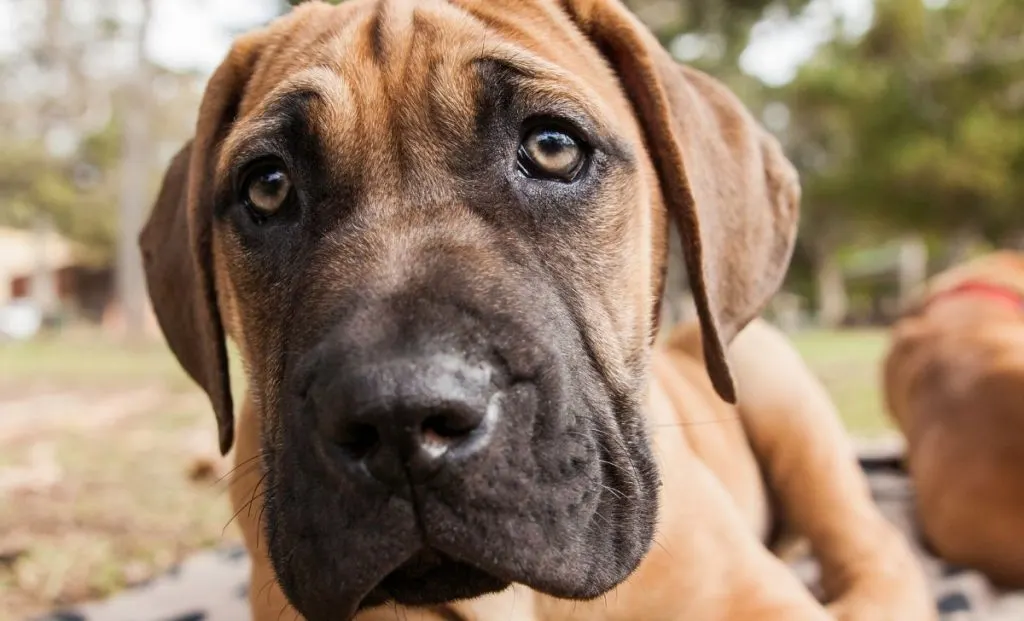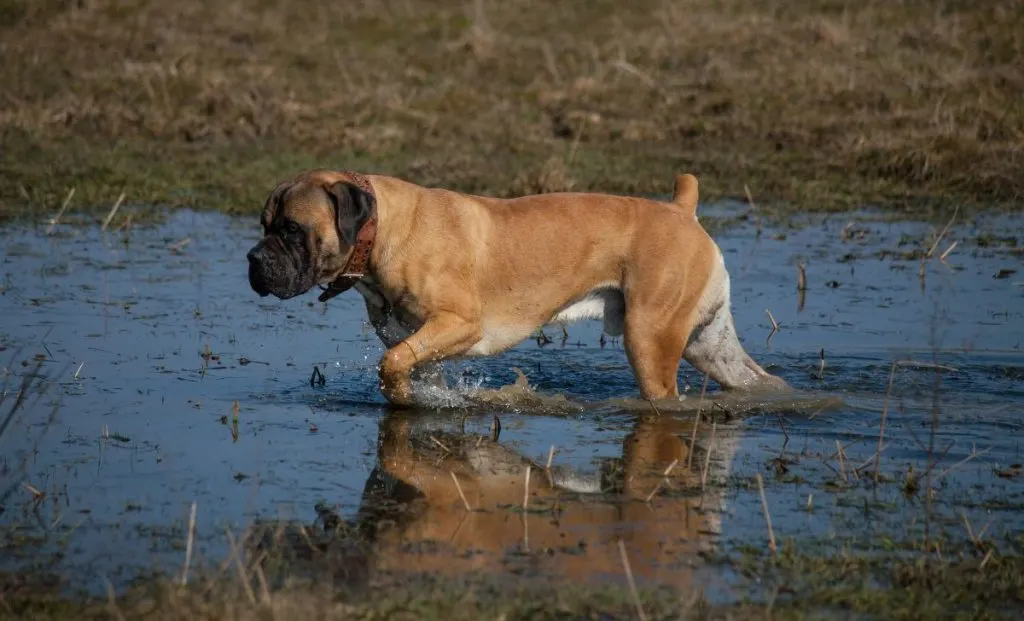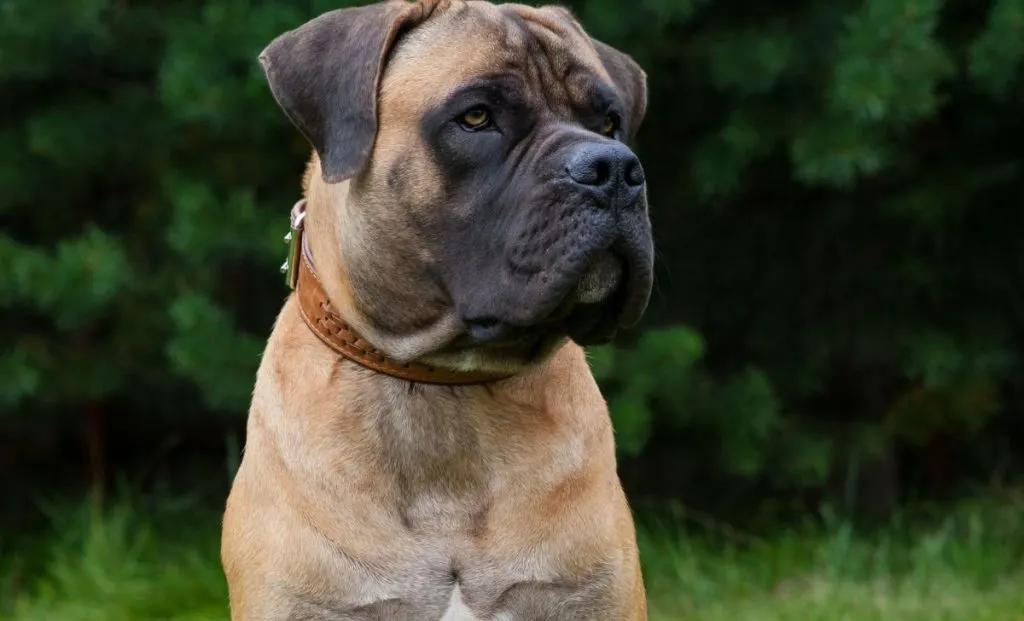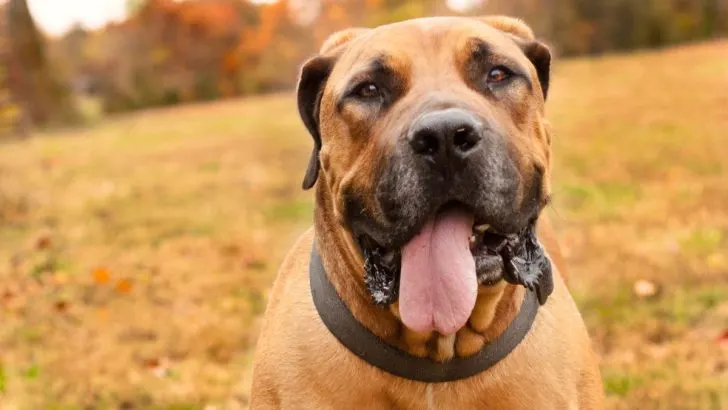Have you just gotten your first Boerboel puppy? Then what you need is a Boerboel growth chart that can help you keep track of his development!
Boerboels originate from South Africa. The name Boerboel is similar to the Afrikaans word for a “farm dog”, so you can already guess why they were originally bred for.
Today, though, these massive dogs are beloved pets and guard dogs, and we want nothing more than to provide them with the best quality of life possible. One of the ways to do so is to make sure they grow tall and strong.
If you want to know what kind of diet can help your Boerboel grow properly or just to check whether your pooch is of the right size, here is a Boerboel growth chart that can help you out in many interesting ways:
Boerboel Growth Chart
| Age | Weight | Height |
|---|---|---|
| 1 month | 5 – 20 lbs | 8 – 10 inches |
| 2 months | 15 – 30 lbs | 10 – 12 inches |
| 3 months | 30 – 45 lbs | 12 – 14 inches |
| 4 months | 45 – 60 lbs | 14 – 16 inches |
| 5 months | 65 – 80 lbs | 16 – 18 inches |
| 6 months | 80 – 100 lbs | 18 – 20 inches |
| 7 months | 90 – 115 lbs | 20 – 22 inches |
| 8 months | 95 – 130 lbs | 22 – 24 inches |
| 9 months | 100 – 140 lbs | 22 – 25 inches |
| 10 months | 110 – 150 lbs | 23 – 25 inches |
| 11 months | 120 – 165 lbs | 23 – 25 inches |
| 12 months | 125 – 175 lbs | 23 – 26 inches |
| 24 months | 150 – 200 lbs | 23 – 27 inches |
Boerboel Growth Stages
Dogs don’t grow at the same rate throughout their lifetime, no matter their size. Just look at the American Bully growth chart, for example!
The dog’s growth is typically the fastest throughout his puppyhood, and they experience a few growth spurts before the first year.
Just remember – all individual dogs grow at their own rate, and if the numbers aren’t too far off, this shouldn’t be a huge concern.
0-4 Weeks
During the first month of their lives, Boerboel puppies are pretty dependent on their mothers. They use their mother for food and protection, as they are blind and deaf up until they reach around 3 weeks of age.
Puppies aren’t overly active during this time, and they usually don’t leave their mother’s side. They’ll spend all of this time eating and sleeping.
1-3 Months

After the first month, puppies start to open their eyes and become a bit more curious about the world around them. They’ll still depend on their mother for the greatest part of their early puppyhood, but they will start wandering off and walking on their own.
At around 6 weeks of age, Boerboel puppies should wean off their mother’s milk and start eating solids. Monitor the weight of dog food closely during this time, as puppies are likely to eat all the food they see! Boerboel feeding charts can help you out with this.
Once they are 2 months old, you or the breeder should start socializing them. This is the time when Boerboel pups learn about the outside world, and some experts guess this is the crucial moment for a puppy to learn how to be friendly toward strangers and other pets.
Most breeders will let you take the puppy home when they are between 8 and 10 weeks, so this is when you are likely to become responsible for your pup.
This isn’t the right time to start exercising your Boerboel or to take him for walks. While this is a mostly healthy breed, too much exercise at a young age can increase the chances of bone and joint disorders.
Also, it is during this time when the first growth spurt occurs, and you might feel as if your dog grows larger each day!
3-6 Months
Between 3 and 6 months, you can expect to see a second growth spurt, although it won’t be as drastic as the first one.
Once your pooch is 4 months old, it’s time to start with walks and training sessions. He should also be fully vaccinated before the 6th month of age, so he can start hanging with other dogs freely.
6-12 Months
Once your Boerboel is 6 months old, you should start switching to his own proper adult food regime. This transition should be done slowly, over the course of the next few weeks, so as not to upset his little tummy.
The dog’s meal time and schedule should also change, and during this time, you should start feeding him more food but fewer times.
Boerboels will reach sexual maturity at this age, so you should take them to the vet for spaying or neutering. This might affect a dog’s size, however, so some people prefer to wait a little bit longer.
Your Boerboel’s growth speed will slow down at this time, and it might seem as if he is gaining weight rather than growing. By the time your pooch is 1 year old, he should reach his full size, or very close to it.
1-2 Years
Large dogs might experience some growth during this time, although this will be minor. The biggest changes can be seen in his muscle mass, as your dog will gain true strength once his growth has ended.
By this time, your Boerboel will be fully prepared for long training sessions, adult dog food, and to take over his duties as the main guard dog in the household.
Factors That Affect Boerboel’s Growth Rate

Have you looked at your Boerboel puppy after reading this and realized he is not the right size for his weight? Don’t panic just yet, as this is most likely entirely normal.
There are several factors that influence the dog’s size. This is especially the case with large dog breeds, as any discrepancies will be very noticeable.
Of course, there is always a chance that your pooch is a late bloomer. Not all dogs will grow at the same rate – just as is the case with humans.
However, if their size is greatly different than what it’s supposed to be, then maybe it’s due to one of these reasons:
Genetics
Genetics determine a dog’s appearance, health, and even growth rate. As such, some dogs are predisposed to grow faster or slower than others.
Ask the breeder about your dog’s parents. Maybe one or both of them were growing at a slower pace.
Of course, this isn’t possible if you’ve adopted your Boerboel, but if this did happen, chances are you’ve already got a full-grown dog.
Genes might also cause your dog to stay smaller or larger than he should have. Most of the time, this too can be predicted by looking at your dog’s parents.
Sometimes, recessive genes might lead to an unpredictable outcome, and it is entirely possible for two Boerboels of regular size to have gigantic offspring.
All of this is entirely normal, and there is little you can do about it – just like you cannot change your own height or how big you were as a child.
What you can do, however, is contact your vet and check if he can do genetic testing on your dog. These dog DNA tests can tell you many things about your dog, including his height, body shape, and also his size.
Nutrition
Another factor that affects the dog’s size is nutrition. Underweight dogs will be smaller than pups that have eaten properly throughout their puppyhood.
Malnutrition in puppyhood can make dogs stay smaller, even if you’ve started feeding them properly in adulthood. This is a common problem in rescue dogs who didn’t have a proper diet before they ended up in the shelter.
On the other hand, fast growth can be caused by your dog eating too much. While some owners might intentionally overfeed their Boerboels hoping they’ll grow larger more quickly, this isn’t recommended – especially if you look at the obesity rate of dogs.
Physical Activity

Every living being needs physical activity not just to stay fit and healthy but also to grow properly. This includes Boerboels.
There are many benefits to providing your dog with a proper amount of physical activity. For example, you’ll lower the chances of joint problems and conditions such as elbow dysplasia.
Another benefit is that physical activity can help your pooch develop properly and grow to reach the right size.
If your puppy doesn’t get the right amount of physical activity, his muscles won’t develop properly. Smaller muscle mass can impact the dog’s growth.
Also, improper muscle mass can be very apparent and it can negatively affect Boerboel’s appearance.
Health
Finally, there are many health conditions and illnesses that might halt the growth rate of your Boerboel dog.
For example, intestinal parasites are one of the main reasons why your pooch might be shorter than his peers.
Parasites eat away dog’s calories to survive. If your Boerboel has a severe parasite infestation, he won’t get enough nutrients to grow properly. This will lead to stunt growth.
Fortunately, once you give your dog proper treatment and he gets free of worms, his growth should normalize. However, some dogs will never grow to be the right size, especially if they’ve suffered for a while.
Some congenital disorders can also halt the dog’s growth, although they are fairly rare. For example, cleft palate and similar conditions might make eating challenging, which will, once again, lead to malnutrition and stunt growth.
Spaying / Neutering
A study has shown that spaying and neutering won’t affect your puppy’s growth rate, but that it might affect the dog’s adult size.
If you fix your dog early on, your dog won’t get the same amount of hormones during ‘puberty’ as he or she would if they were spayed or neutered later on. This will typically delay their maturity, causing them to grow taller.
Because of this, it’s always important to consult with your veterinarian before fixing your pup.
Most experts recommend spaying or neutering your dog between 6 and 8 months of age. However, when you have larger dogs, some people suggest waiting until your pup is one year old as this won’t affect his growth.
Of course, some people want their dogs to grow larger, so they might intentionally fix them early on. This isn’t recommended, except if there was some underlying health issue that required early spaying or neutering.
What If Your Boerboel Is Too Big?

While most people are worried about their large breed dogs being too small, the opposite isn’t good, either.
One of the main reasons why your pup is growing too fast is obesity. According to the Association for Pet Obesity Prevention, a staggering half of the dog population is obese!
As puppies can be little vacuum cleaners when it comes to food (or just about anything they can fit in their mouth!), they can gain weight really fast. We tend to ignore this when they are small as we find it cute – until their body condition significantly worsens.
Some common problems of obesity include:
- Diabetes
- Heart conditions
- Joint problems
- Skin conditions
- Kidney disease
- Lack of mobility
- Cancer
- Decreased quality of life
- Shortened lifespan
If your dog has become overweight, don’t worry. You can still be a better pet owner and help him get back on track – literally and figuratively.
Some signs of obesity in dogs include:
- You cannot feel your dog’s spine and ribs
- His waistline has become too big
- Your Boerboel is refusing to go on walks
- Excessive panting
- Your pup needs help getting up or down the stairs, in and out of car seat, and so on
The first thing you should do if you suspect your dog has outgrown the Boerboel growth chart and has become obese is to take him to the vet. A professional can help you determine the right method of helping your dog lose weight.
This can include changing the feeding routine, exercising more, and taking certain medications.
Obesity can be even more deadly than malnutrition, so don’t take this lightly.
Tips To Help Your Boerboel Grow
If you’re worried about your Boerboel being too small, you’ll be happy to hear that there are several things you can do to help your pup reach the right size.
This is important not just so your guard dog can look intimidating but also for proper development.
If your pup isn’t following the Boerboel weight chart, you might need to help him out a little bit.
There are several reasons why a Boerboel might be underweight, such as:
- He is a picky eater.
- He is stressed out.
- He is too lazy or too active.
- He is old.
- You aren’t feeding him enough.
- He is ill.
It isn’t possible to affect some of these factors, such as old age. Also, if a dog is struggling with some health condition, the only solution is to contact your vet and decide on a treatment plan.
However, there are some things you can do to help your pup grow big and strong. Even if you have an older dog that is losing weight, you can still try a few methods that might help him return to a healthy weight.
Here are a few tips and tricks that you can do to help your dog reach the proper size:
1. Proper Diet
Your dog needs proper nutrition to grow. Your Boerboel needs food specifically formulated for large dog breeds, as they have different needs from small dogs.
Dogs don’t need as much carbs as we do. Instead, the focus should be on proteins and fat – although, of course, a balanced diet does require some carbs and other nutrients, as well.
The best healthy dog foods always have a protein source listed as the first ingredient. You don’t need to choose an expensive brand; just monitor the ingredients.
Some common protein sources include poultry, beef, and fish. Some dogs might prefer specific types of meat, so feel free to experiment a bit, especially if you have a picky eater.
You should also look for other nutrients, such as vitamins, omega-3 and omega-6 fatty acids, amino acids, probiotics, and prebiotics for added benefits. These can help improve your pooch’s health and promote puppy weight gain.
Just remember that any change to a dog’s diet should be done slowly. If you immediately switch from one food to another, you are risking diarrhea, vomiting, and stomach upset.
Not to mention how you can never know whether your pup will be sensitive or allergic to certain ingredients in the new type of food!
Because of this, it’s a smart idea to always stay in contact with your vet when switching to a different kind of dog food.
2. Change The Feeding Schedule

If your dog is getting the much needed nutrients, but you notice his weight still hasn’t improved, maybe you need to change the feeding schedule.
Most feeding experts suggest feeding your adult Boerboel twice a day. However, for weight gain, you might want to give them the same schedule they had when they were puppies, which includes eating smaller portions three to four times a day.
This is a great weight-gain tactic, as it affects the dog’s metabolism and helps increase weight – especially if you don’t go more than 6 hours between meals.
Also, this type of feeding might help dog owners who are keeping track of their puppy weight calculator and journal, as it gives them a deep understanding of just how much food their Boerboel pup is eating.
3. Weight Gain Snacks
Next to proper food and a good feeding schedule, you might want to supplement your dog’s diet with weight gain snacks.
Weight gain snacks contain specific nutrients that can help your dog gain weight. They are especially useful for large dog breeds, as these canines require more calories and nutrients to reach the recommended size.
They are also a good way to make your dog eat more often without going overboard, as they shorten the time between two meals.
Just remember to monitor the amount of calories your pup is eating. Also, make sure to read the instructions properly and to give your Boerboel just the right amount according to his age group. Even an old Boerboel puppy cannot eat as much as an adult dog!
4. More Exercise
As mentioned before, the weight of a dog is greatly impacted by the amount of exercise he gets.
Exercise can promote the development of muscles, which will, of course, impact the overall weight.
Not to mention how the proper amount of exercise is great for your pup’s health, as it can prevent certain health issues such as back problems or even heart diseases!
Physical activity also increases a dog’s appetite, so this can help picky eaters, as well.
Just remember that balance is the key and that too much exercise is just as bad as no exercise. Dogs lose calories when they are active, and they might lose too much, causing them to become underweight.
5. Rule Out Health Problems
Another important thing you need to do is to take your dog to the vet to rule out any possible health complications.
Don’t let Boerboel’s size fool you. This can be a delicate dog, and he might need veterinary assistance even though he might appear healthy other than the apparent small size.
Vet visits are especially important if your pooch has had the right weight but has become skinnier or if he has experienced sudden and significant weight loss.
Even if everything is okay health-wise, this can be the opportunity to talk to your vet about possible changes in diet or exercise regimes.
Write Down Everything
Finally, one of the main things that can help you keep track of your dog’s progress is to keep a weight journal and write down everything.
Take note of everything your Boerboel eats, including when he eats it and the portion size. Weigh him regularly and monitor how his weight changes. This can help you notice patterns and see what works best for him.
Not to mention how this journal can be useful during the next vet visit.
Does Size Really Matter?
Let’s face it: We all want our large dogs to grow to be… well, large. This is one of the reasons we’re looking at Boerboel weight charts: We want to predict our dog’s size and check if there’s something wrong.
However, in this case, size does matter. A dog that isn’t healthy is typically going to be too small for his age and breed, and this is one of the possible signs that something needs fixing.
This is why it’s important to monitor your Boerboel’s weight and make sure he is of the right size. Your puppy needs to grow strong to be the best dog possible.
And if, due to genetics or any other reason that doesn’t affect his health, your pup remains smaller than he should, this doesn’t make him a bad pet. All dogs deserve love, no matter their size.

Vanja’s passion for writing started at an early age, which is why she pursued Journalism as her college degree. She can research any topic and find all the information before you bat an eye, which is a great thing for her job but a terrible one for her husband.
Even as a young child, she fell in love with everything fluffy – but dogs have a special place in her heart due to her childhood companion, a Corgie named Archie.
Motivated by her experiences and driven by a desire to give back to her four-legged companions, she spends her free time volunteering at a local dog shelter.
